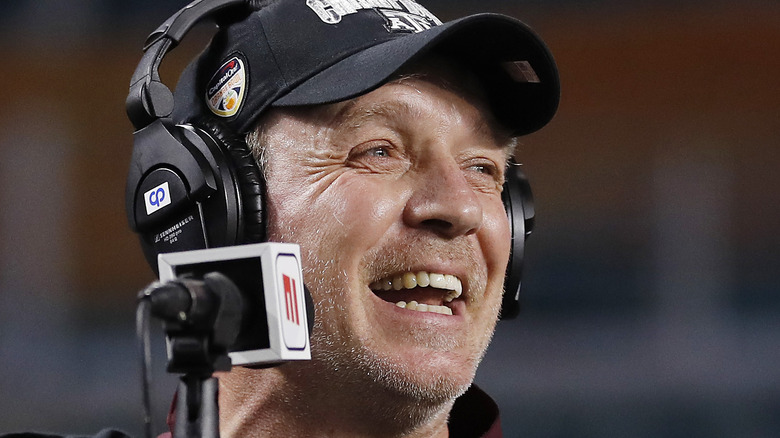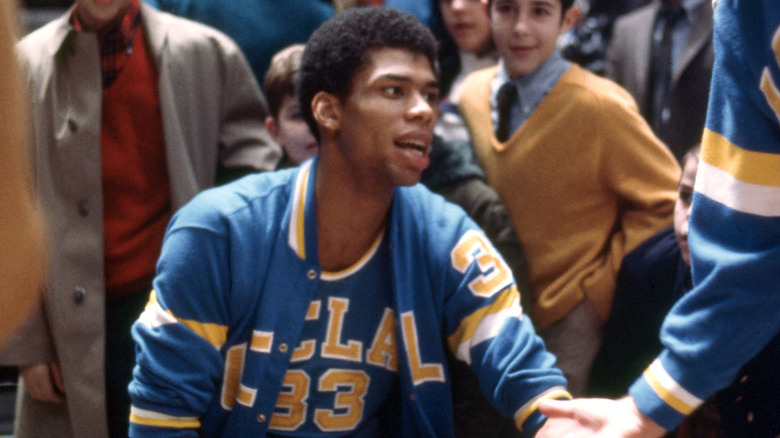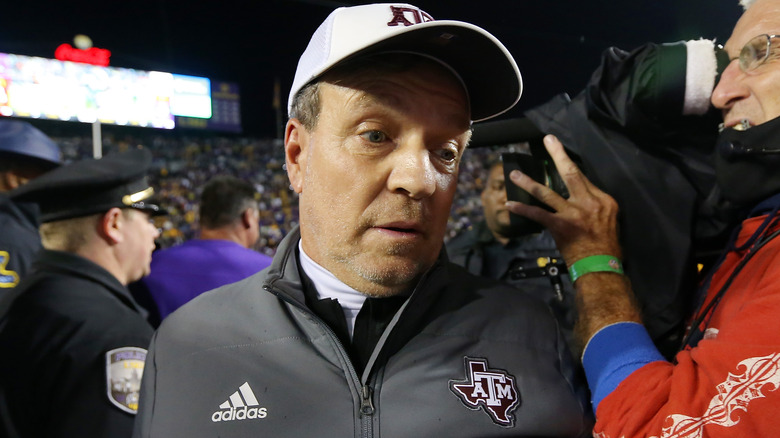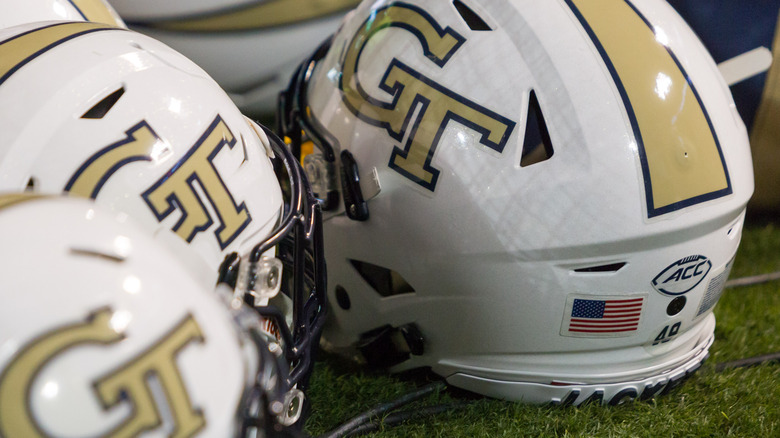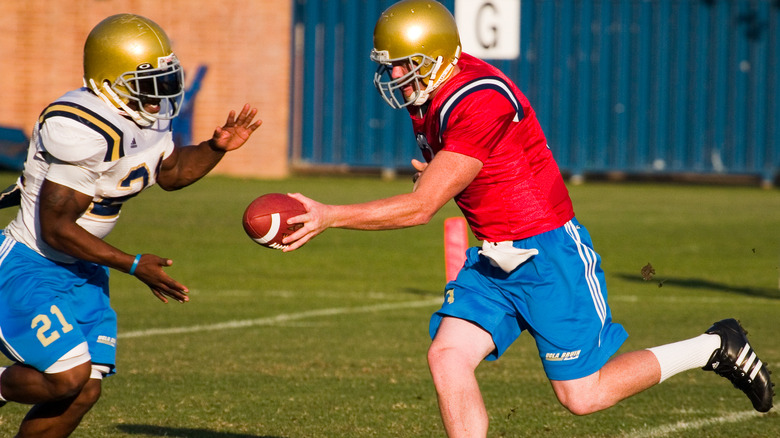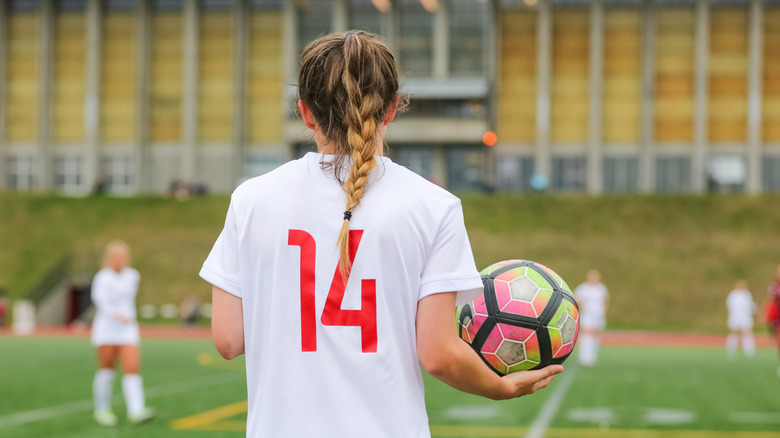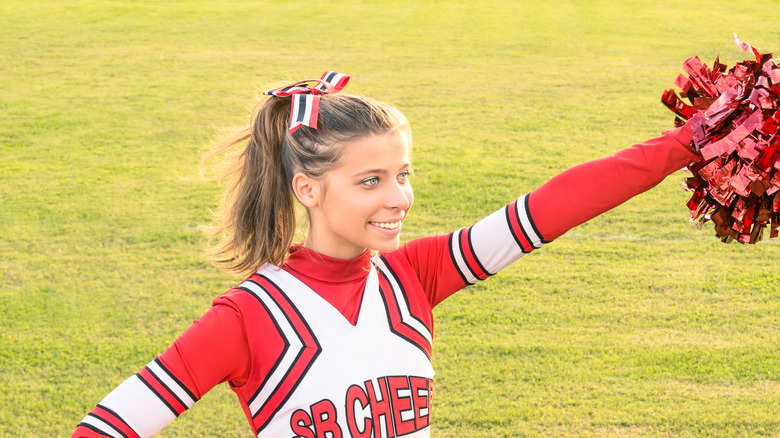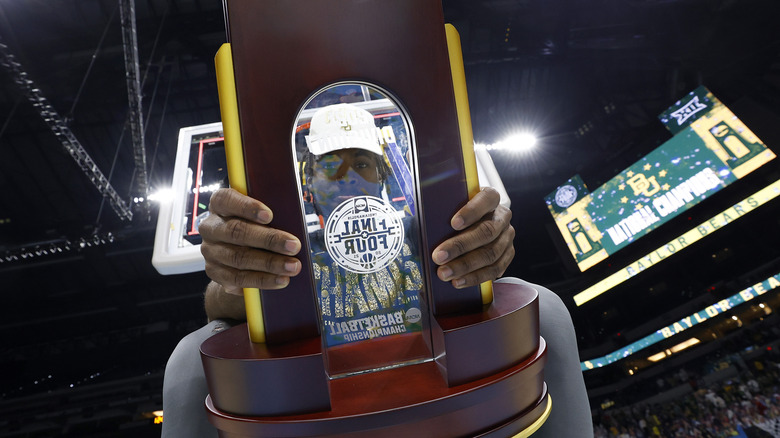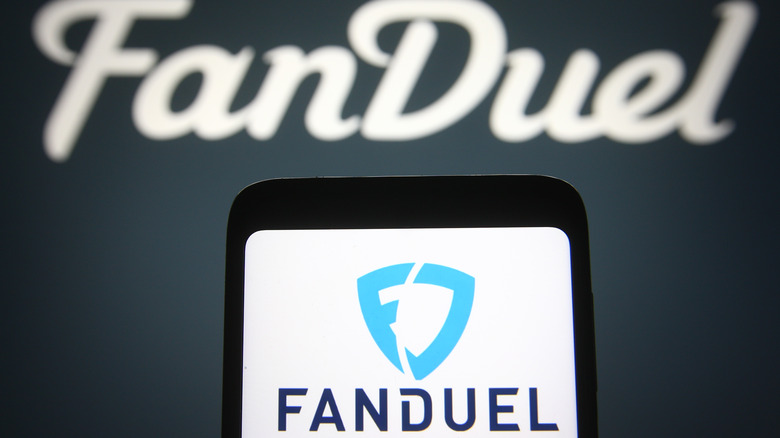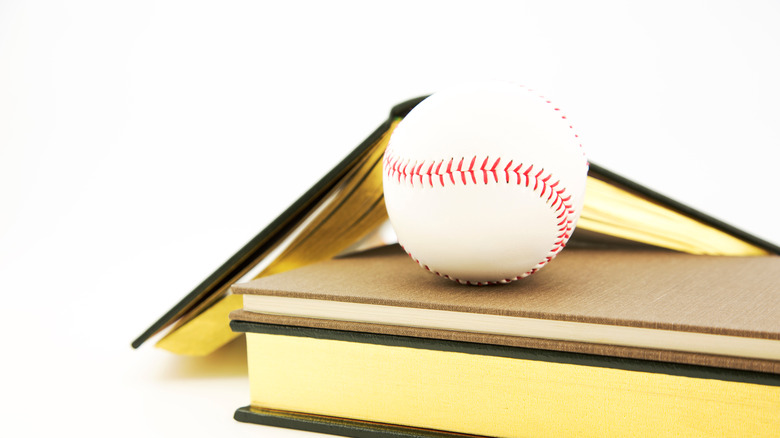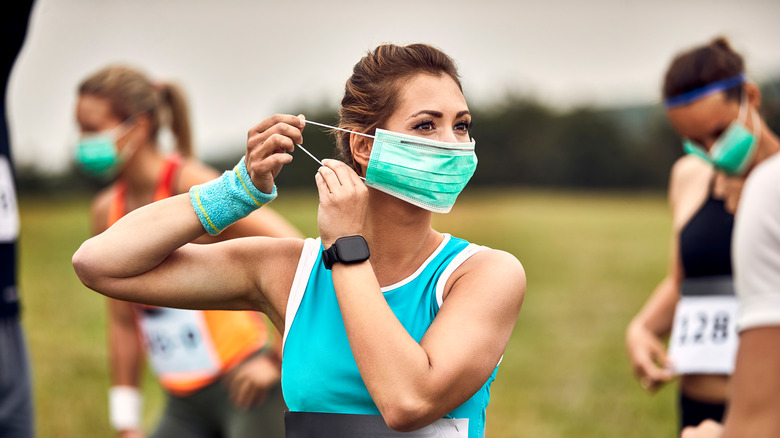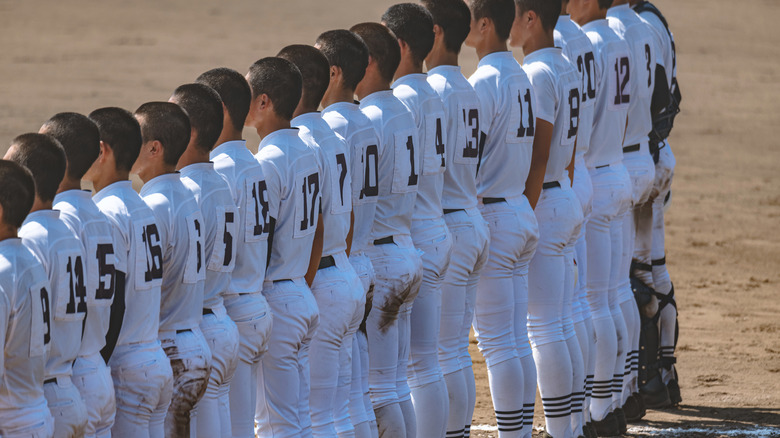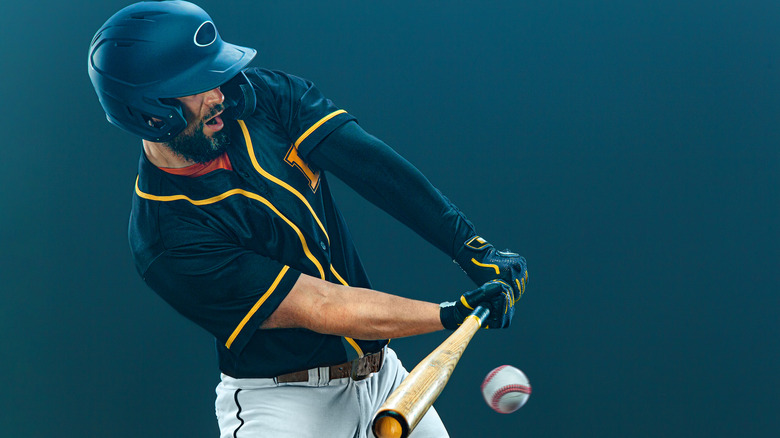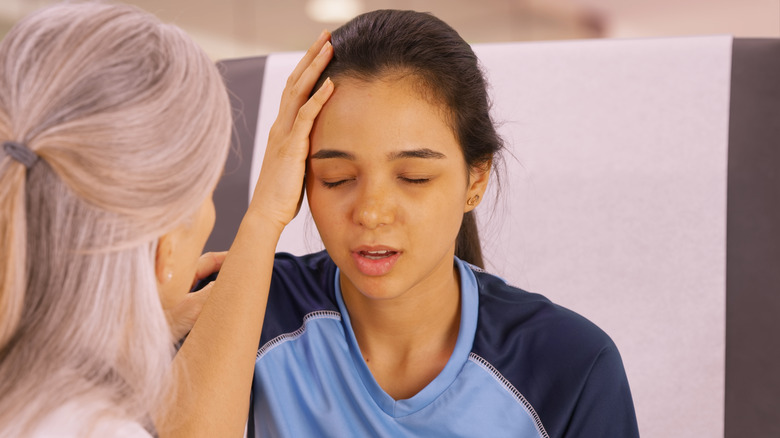Secrets The NCAA Tried To Hide
How far-fetched is it that the NCAA — the National Collegiate Athletic Association — has something to hide? Beyond the fact that college athletes are more likely to be disciplined for sexual assault or that the lawyers who took on the NFL over concussions are coming for the NCCA, need we remind you it's a billion-dollar industry?
Augustine Of Hippo elegantly once said, "for the love of money is the root of all evil." Not to be outdone, Notorious B.I.G.'s classic "Mo Money Mo Problems" infectiously sings the same tune (albeit to a beat that is much more hip). Then there's Robert Redford's iconic scene in "All the President's Men," where, when talking to Deep Throat, is advised to "follow the money" as a tip-in he and Dustin Hoffman's quest to crack Watergate.
The point is, the rule for uncovering political corruption is the same for corruption anywhere: follow the loot. And with the NCAA, there is a lot of it. From multi-million dollar endorsements from sponsors to its own video game franchise and arguably the most die-hard fans in all of the sports across the spectrum, it would almost be shocking if a business this big was as clean as a whistle. The NCAA may not been as forthcoming about some of their dealings in the past, but what's done is done, which, with these 13 secrets, we shall undo.
The NCAA banned the dunk from 1967 until 1976
History is a significant part of sports consumption. There's nothing a bunch of jocks love more than sitting around comparing all-time greats eras and match-ups. Sports franchises, leagues, and associations alike frequently reflect on the legends of old and are quick to pull up vintage footage of their titans of yesteryear. It's a fraternity shared by both the players and the fans that help make sports what it is and, as a result, has become an archive of memories that millions are connected to forever.
So it's super confusing as to why no one ever talks about how the NCAA banned dunking for nearly a decade! Yes, you read that correctly: using your athletic ability to jump off the ground and place the ball through the net with your hands was deemed illegal.
Now, to be fair, the NCAA banned the dunk for a number of reasons. Defenders at the time felt like the move was disrespectful and would often sweep at the legs of these high-flying pioneers. But they also were snobby purists about the game. The dunk, to use the organization's words, "was not a skillful shot." Although still not officially proven, the NCAA's comment definitely backs up the rumor that the real reason the rule was made was because of UCLA's Lew Alcindor (Kareem Abdul-Jabbar), who would regularly dunk over his opponents. The media even nicknamed it the "Lew Alcindor rule," which stated that players weren't allowed to make shots above and directly over the cylinder.
College athletes have been getting paid illegally for years
While the 2021 NIL deal has officially deemed student-athletes eligible to profit off their likeness, the truth of the matter is that they've been getting paid for years. Everyone on all levels, from the coaches to the trainers — and most likely the NCAA — has always known about it.
Jimbo Fisher, Texas A&M's 10-year, $75 million head coach and winner of the 2013 Division I FBS championship, is among the first head coaches to come out and openly say college football players have been paid under the table. Careful not to indict himself, his own program, or others when commenting to the Houston Chronicle, Fisher said this new deal is, well, nothing new. "NIL has been going on for a long time," Fisher said. "It just hasn't been above board. Now it is, and I think it does affect things. Because other people don't have the advantages they used to have, and how they did things and the way they did things."
You can believe that the NCAA was unaware of what was going on, but if a championship-winning, seven-figure salary coach says it was commonplace, deductive reasoning would lead you to believe he wasn't the only high profile name complicit. It's just a secret that the NCAA would rather you never know or even believe.
Students could have been getting paid
The thing is, student-athletes and coaches never had to go under the table for deals. There were ways for them to get paid, hidden in plain sight within the fine print the entire time. What many people do not know and what, arguably, that NCAA didn't want people to find out, was that the rulebook always allowed student-athletes to make money by teaching private lessons.
The rule is called "Fee-for-Lesson," and was one of the few ways the NCAA allowed student-athletes to profit off their athletic ability without harming their eligibility. Per the Georgia Tech Athletics handbook, "student-athlete may receive payment for teaching or coaching sports skills or techniques ... in his or her sport. A student-athlete may only receive a fee-for-lesson if: Georgia Tech facilities are not used; instruction occurs (no competition or playing lessons may take place); the student-athlete completes and submits the Fee-for-Lesson Form to the compliance office prior to the lesson(s)."
Granted, it's not the same as making money off just being you. For example, according to CNBC, "Chloe V. Mitchell, a freshman volleyball player at Aquinas College in Grand Rapids, Michigan, is believed to be the first college athlete to make money from her likeness. In fact, she's already gotten sponsorships from her millions of TikTok followers that paid for her school laptop. But imagine the amount of money Zion Williamson could have made with private lessons when he was in college just off his name alone. We guess, as they say, it's the more you know.
Not-so-secret scrimmages
The NCAA doesn't want you to see practice scrimmaging. According to the NCAA rulebook, Division I members can trade one or both of their allotted exhibition games against non-D-I opponents for a scrimmage "provided they are conducted in privacy without publicity or official scoring." It goes on to say that "individuals other than athletics department staff members and those necessary to conduct a basketball scrimmage against outside competition may not be present during such a scrimmage," according to NCAA rules passed in 2005.
Why? Well, no one knows why. The NFL doesn't seem to have a problem with this. Their teams conduct joint practice sessions during the offseason all the time, which, after all, is the gridiron equivalent of a pickup game. Besides, fans often find out about these matchups, even though they're never publicized anyway.
However, the coaches seem to love it. The term "distractions" gets thrown in a lot, although some of these kids are being groomed for superstardom and celebrity, and their loyal fanbases seem to support them. However, one theory is that the rule was put in place in case a big-name team gets beat by one of the non-D-I opponents, which would totally make sense. Until then, it remains one of college sports' biggest mysteries.
Coaches psychologically abused girl students-athletes
Although there have been 17 former college athletes at seven schools citing patterns of alleged psychological and emotional abuse in women's college sports going back to 2012, the NCAA, which functions as the regulatory body for US college sports, has consistently declined to comment on the issue of psychological abuse by coaches.
From hazing in college softball that left one girl with a broken nose, fractured teeth, and a concussion, to a Northern Kentucky University's women's basketball program that caused eight girls to quit over humiliation and intimidation, the investigation by Insider gives both a detailed look at the lives of some student-athletes as well as the willful negligence from the NCAA during this time.
Unfortunately, cases like these are a dime a dozen, but with mental health awareness on the rise, college athletes began to rebel against abusive coaches — although the NCAA remains unmoved on their stance. Not only did they decline to comment to Insider on the issue, Cornell University, Northern Kentucky University, and Ohio Dominican University all "conducted investigations or reviews in response to allegations of abuse," which they all concluded no wrongdoing. Similarly, when former Nebraska Cornhusker softball players found out a verbally abusive coach was being reinstated, they contacted College Athlete Advocacy Initiative (CAAI) — a group fighting for collegiate athletes' rights with legal support and advocacy campaigns — not the NCAA for help. We wonder why?
Sexual abuse, countless times
Along with bullying and psychological abuse, the NCAA has also overseen their student-athletes become sexual assault victims. The NCAA has been so eager to ignore and look the other way, in fact, that three former students filed a federal class-action lawsuit stating the institution categorically failed to prevent sexual harassment and abuse by coaches and should be forced to enact policies that protect student-athletes
"Without NCAA rules requiring member institutions to report predators like [John] Rembao to the NCAA, Rembao moved among NCAA schools, preying on female track and field student-athletes. Rembao's unfettered sexual and emotional abuse physically and emotionally damaged multiple student-athletes, including plaintiffs," the complaint states.
Sadly, it appears that sexual assault is so low on the NCAA's priority list. Student-athletes can receive punishment for bad grades, smoking pot, or taking money, but there aren't specific penalties for sexual assault (via South Bend Tribune). What's inconceivable is that a student-athlete can be accused of sexual assault by two separate students, arrested for sexual battery by police, and expelled from a school, then go and get picked up by another D-I team to play in front of millions. That was the case with one LaDarrius Jackson. The NCAA argues that they cannot be held legally responsible for sexual abuse on campuses nationwide, but the truth is they want it swept under the rug, or else they'd take action.
If you or anyone you know has been a victim of sexual assault, help is available. Visit the Rape, Abuse & Incest National Network website or contact RAINN's National Helpline at 1-800-656-HOPE (4673).
The odds of picking a perfect bracket are 9 quintillions to one
Every year, the NCAA's March Madness is one of its most lucrative moneymakers as millions are hyped up to indulge in Division I's biggest basketball tournament of the year, as well as participate in the popular tournament bracket. The marketing is elaborate. Commercials are prevalent on every device with a screen and streaming subscription; employers ask you to fill out an empty bracket as a fun team bonding exercise, they're on the back of your Oreos at the grocery store, and even churches will collectively fill them out — it's almost like a holiday for crying out loud.
But why? The real question here is why are so many people excited about filling out brackets when, in reality, there's a snowball's chance in hell they'll ever win? It's the NCAA's biggest secret that, with some basic math, becomes their biggest scam: the truth of the matter is that odds of making the perfect March Madness bracket are 1 in 9.2 quintillions, per NCAA.com.
The numbers were crunched by the NCAA themselves, although, even, still, they're gaslighting with this caveat: "Again, this is not a completely accurate representation of the odds, as any knowledge of the sport or tournament's history improves your chances of picking games." Yeah, right, like any amount of sports knowledge would give someone the power to crack those odds.
Student-athletes gamble
Perhaps the NCAA likes people to buy into low odds because student-athletes are still gambling without any real implication of a resolve put in place. 24% of male and 5% of female student-athletes reported being sports bettors last year, according to the NCAA, despite it completely being banned in the bylaws. The number might seem low, but the implications are much more severe, as college students not only have higher rates of gambling participation and gambling problems, they also have higher rates of risky behavior.
Whether the parents of these student-athletes think gambling is morally wrong or not — one survey by the National Council on Problem Gambling found that only 14% of Americans find gambling immoral — there's no argument against its potential to derail your life, as the same study found that 63% say operators of legalized gambling venues should have to implement responsible gambling measures. Another study, in fact, finds that 16% of online sports gamblers "met clinical criteria for gambling disorder." Yet the NCAA doesn't talk about that much.
The problem is that there's not much incentive for the NCAA to care, especially when the NFL, which is the dream destination for many of these college athletes, is projected to make $270 million in revenue from sports betting and gambling deals in 2021 alone. It makes sense why the NCAA hasn't spoken out too much on the potential harms gambling could have for these young adults.
Full-ride scholarships don't exist, really
The NCAA markets itself as the dream destination for high school athletes but, in reality, not even two percent of these students will receive a full-ride scholarship. It's a part of the same false narrative that "higher education is the only way to a successful life in America" kids are told entering high school.
The thing is, the NCAA is actually great at selling dreams. We've all seen the commercials during primetime college bowl games: the student with a full set of pearly whites and book bang over one shoulder waiving in slow motion with a gorgeous backdrop of the campus, where, in the end, without fail, there's always someone that asks "what you're waiting for?" as if enrolling in college and spending an absorbent amount of money on a degree that may or may not still be there when you graduate was that thing on your daily to-do list you've been meaning to scratch off.
According to Aquinas American School, "there are roughly 138,000 athletic scholarships available for Division I and Division II sports." And even if you are one of that privileged one percent, "the average athletic scholarship is about $10,400 per year," or $8,700 if you don't play men's football or basketball. What makes matters worse is that the money awarded is conditional and on a yearly basis — nothing is guaranteed. Long story short, test out your options and maybe get that academic scholarship because full-ride academic scholarships don't exist.
The second most common sport after basketball might surprise you
While funding is primarily distributed to football and basketball, don't let the NCAA fool you into thinking they are the most popular sports on the campus. Basketball and football might be the most lucrative, but, in all honesty (and what they'll probably never publicly admit), cross country is the second most popular behind basketball. Football doesn't even rank in the top two (via Insider).
Cross country can credit its popularity to being a low-maintenance sport. For starters, it doesn't require the sexy bells and whistles — like a stadium arena and expensive equipment — like other sports. The fact that cross country can be played by both men and women helps too.
Arenas, large fields, and expensive equipment aren't needed in order for an institution to have a cross country program. Because football and basketball bring in the most money, it's the programs that give the most scholarships, despite the majority of others who prefer a different program.
Coaches don't follow the 20-hour rule
A recent issue of the Division I manual under Bylaw 17.1.7.1 states: "A student-athlete's participation in countable athletically related activities shall be limited to a maximum of four hours per day and 20 hours per week." What the NCAA doesn't want you to know is that rarely is this rule implemented. The more you read into the rule, in fact, you'll see that student-athletes are responsible for far more than what's broken down as "athletically related activities."
The list of required (but non-countable) activities included compliance meetings, organized team promotional activities, student-host duties, media appearances, fundraising events, team-building activities, travel to and from the away-from-home competition, and the list goes on. According to one lawsuit against the University of North Carolina Chapel Hill and the NCAA, collegiate student-athletes may spend more than 40 hours a week practicing, leaving little time to keep up with academic commitments.
Student-athletes are stressed out
Student-athletes are so pulled in every direction all at once. As detailed in a study by Northeastern University, "Recent statistics indicate that 95% of male and 85% of female athletes report higher stress compared to 52% of non-athlete students." The study went on to say that "athletes report higher stress in romantic relationships, higher responsibilities, decreased sleep, and extracurricular activity demand," which, as we pointed out earlier, is put on them illegally. Additionally, these athletes aren't sleeping.
Along with COVID, one fact could very well be the 20-hour rule that's being completely disregarded. College athletes are traveling, dealing with the pressures of teammates, coaches, and pressures of winning. Among other things, they've been experiencing health risks that include insufficient sleep, exhaustion/fatigue, digestive problems, elevated anxiety, and performance-related burdens.
According to The Washington Post, there's a viral video of an ex NFL player parodying the NCAA's student-athlete culture, and former NCAA athletes that have spoken candidly about how actually grueling their schedules are. Emmanuel Acho shared with the outlet, "the aspect of study hall till the wee hours of the morning, and also the eating on the go. There's rarely time for nice, relaxing sit-down meals." It's highly unlikely that recruiters are passing on that information.
Concussions concerns are coming
Remember when the NFL went through that tumultuous lawsuit over head injuries that led to a massive $1 billion class-action settlement? Well, the same lawyer is taking on the NCAA "case by case by case" in courts across the country.
According to SI, the lawyer's name is Jason Luckasevic, and he is trying an individualized approach at compensating and serving these former college athletes because of how the NFL settlement went down. Out of the more than 20,000 eligible former NFL players, only 5% have been paid in what Luckasevic describes as a "quagmire debacle." Now, he and his team are taking on cases one at a time, with eyes on getting these players the justice they deserve.
So far, as of this writing, he's brought eight suits against the NCAA in four states, with five others being prepared and more backlog due to the pandemic. Luckasevic's objective is to get the jurors to understand how NCAA should have known playing football could lead to long-term brain disease well before all the research and attention. Whether he wins zero, one, or all of the cases, the attention will definitely bring a spotlight and a moment of reckoning for the NCAA.

